At the food bank in Maassluis, in the Netherlands, they eat very special lettuce these days. Remarkable in taste and cultivation. Below, Vincent and Chris van der Gaag of Urban Agrotech and Boris Prins of Fixum Solutions explain the story. The men developed a container farm with a unique rotating system. For three years, the project was kept a secret, but this month The Plant Factory became public.
"After a while, we could no longer distribute the entire yield among our family and friends," says Chris. As a greenhouse builder with extensive experience in the industry he and his son, who has a background in engineering, came up with the idea a few years ago to 'do something new'.
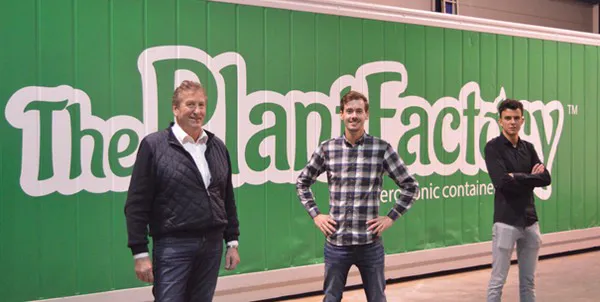
Chris and Vincent van der Gaag of Urban Agrotech and Boris Prins of Fixum Solutions in front of the 12-meter-long container farm.
Proven concept
A container was bought and experimenting could begin. Vincent: "We did a lot of trials and tried different setups. All possible plugs and fertilizers were covered, but finally, after three years, we have a proven concept. It is a unique concept that allows us to double the yield compared to the usual container farms on the market.”
Here is where Boris comes in. He joined father and son Van der Gaag to also think about and contribute to the container farm. In collaboration with Brent van Paassen of Van Paassen Techniek, it resulted in a pneumatic-driven system where lettuce and herbs make a lap through the container according to a first-in, first-out principle. This while the lettuce and herbs grow in self-developed vertical cultivation towers in which a fertilizer mist is sprayed onto the roots. "This aeroponic way of cultivating means that the roots of the plants can absorb the fertilizers better, partly due to the increased oxygen content," says Vincent.
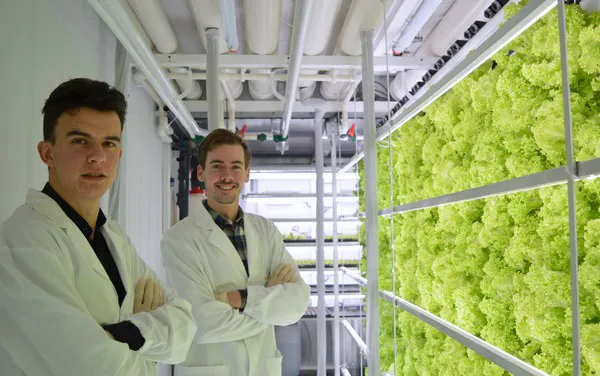
Boris and Vincent in the demonstration container, in which only one rotating system is built so visitors can see how it works.
Patent pending
Aeroponics and vertical farming are not new. The rotating system is. For this unique system that has emerged from the collaboration patent is pending. But all the other parts of the container are also well thought out. Vincent: “We work with an air handling unit that can handle up to 3,000 cubic meters per hour. As a result, the total air content of the 12-meter container is circulated every 90 seconds. The water that evaporates in the container is stored. For the on average 6,000 plants in the container only 30 to 40 liters of water needs to be added every day."
Energy consumption is also as low as possible. The LED light spectrum bulbs, with which the container is equipped, contribute to the lower consumption. “Due to the high quality of the lighting, we have noticed that we need fewer micromoles than is normally applied to lettuce. This means that we need fewer lamps, of which we do not need to cool their heat."
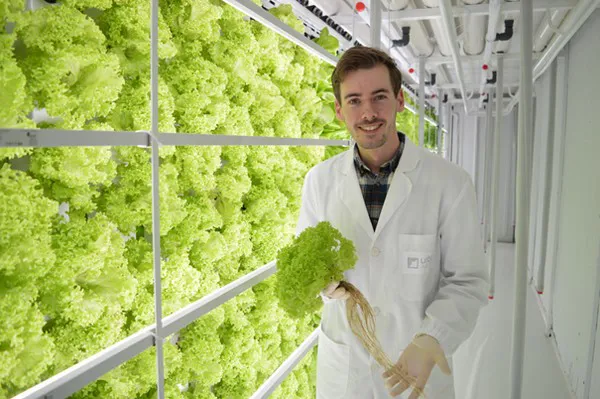
Beautiful white roots, that's what growers like to see. Automatic control of the fertilizer and irrigation unit helps to achieve this. EC and PH sensors determine the quantity of fertilizer in the irrigation water. A second reading checks the first reading, after which an alarm may be triggered if abnormal values are detected.
Steady climate
It is also striking that the climate is almost the same throughout the cell. That's not always the case, Vincent knows. "Temperature differences are often a problem in vertical farming. Because we have 0.3 meters per second of air circulation and we inject the air between the plants, the temperature between the lower and upper cell only varies by 0.2 degrees Celsius. That's very little.”
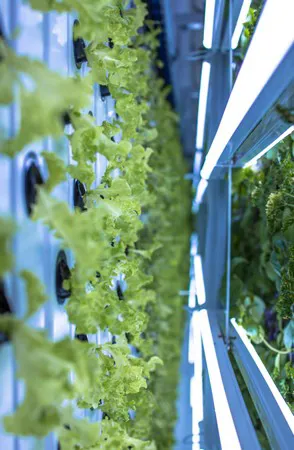 The men admit that they don't have green thumbs. Yet the container farm has spectacular yields. "We started working together with cultivation specialist Ton Enthoven. He is a highly-valued colleague and has contributed a great deal to the development of the technical aspect of the container farm. All this to make sure the plants get exactly what they need.
The men admit that they don't have green thumbs. Yet the container farm has spectacular yields. "We started working together with cultivation specialist Ton Enthoven. He is a highly-valued colleague and has contributed a great deal to the development of the technical aspect of the container farm. All this to make sure the plants get exactly what they need.
Photo on the right: the lettuce grows in vertical cultivation towers, so the picture is projected correctly
“The dill and basil we grow in the container have a very intense taste and could be kept in a fridge for a long time.” That basil is also successful is not self-evident. It's difficult to cultivate basil. "After many trials, we selected lettuce and herbs that can be grown together in a single container with the current configurations. These are butterhead lettuce, lollo bionda, incised lettuce, parsley (flat-leaf and curly), basil, coriander, mint, dill, and celery. In the meantime, we continue experimenting with other crops to expand the product range.”
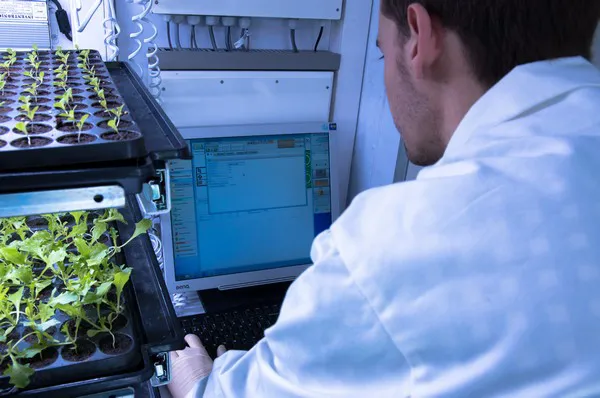
Convenience
Even two products with different growing cycles from that list can be grown in the container at the same time. Boris: “This is possible because the container is equipped with two rotating carousels. There is also no path in the middle, so as many plants as possible fit in the container.” Vincent adds: "In the container a small space is reserved for the technical equipment and as workspace. Here the plants are bred, planted, harvested and processed, all on about 4m2.”
They target growers that have little to no experience. "The container should make it easy for growers. The system is nearly plug & play. Growers should not have to worry about it. As long as they take care of sowing, harvesting, packaging, and filling the fertilizer drums, and cleaning the growing towers. For one person, that's 3.5 hours of daily labor."
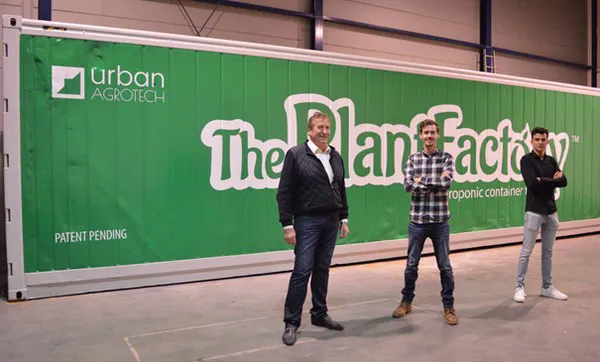
Not in the picture, but the climate unit is behind the container. The climate unit is still quite big, but the men know that it can be a lot smaller. New containers will be fitted with those smaller ones. It further reduces energy consumption and gives more space.
Potential customers
The first container is owned by Ton in Belgium. He's busy testing new crops. Urban Agrotech installs the container and provides a two-day start up support. There will probably be a lot of demand for the containers from restaurants, supermarkets, in remote areas with difficult cultivation climates or on ships. Chris: "A container ship can take up to 12 weeks to go from Rotterdam to Australia. If you have a container farm on the boat, you will have fresh food every day without too much hassle. We have been doing the same. Good to see, after years of development behind closed doors.”
For more information: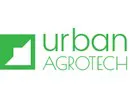
Urban Agrotech
Oud Camp 4b
3155DL Maasland
The Netherlands
www.urban-agrotech.com
info@urban-agrotech.com
+31 (0) 638 256 400
Fixum Solutions
Westlandseweg 11
2291 PG Wateringen
The Netherlands
www.fixumsolutions.nl
info@fixumsolutions.nl
+31 (0) 634 930 819
